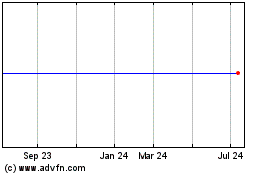John Mackey Will be Sole CEO of Whole Foods Market
November 02 2016 - 6:20PM
Dow Jones News
Whole Foods Market Inc. said Wednesday it was eliminating its
dual-CEO leadership structure at the end of the year, leaving
co-founder John Mackey alone atop the struggling grocery chain.
Mr. Mackey's co-CEO, Walter Robb, will step down from the
position on Dec. 31 and remain on the board of directors and as a
senior adviser to the company. Mr. Robb has shared the chief
executive duties for the past six years of his 25-year career with
Whole Foods.
In a further shake-up, the company also said Chief Financial
Officer Glenda Flanagan would retire from the post after 29 years
at the end of the 2017 fiscal year. She will also continue in a
senior adviser role.
Mary Ellen Coe, vice president of sales and product operations
for Alphabet Inc.'s Google, has also joined the Whole Foods
board.
Mr. Mackey has spearheaded a nine-point plan to turn around his
stumbling company, which includes more promotional discounts in its
stores and a new, less-expensive spinoff chain called 365 by Whole
Foods Market.
The company has gone through a serious downturn, hurt by
increased competition in the market for natural and organic foods.
On Wednesday, it posted fourth-quarter results that cemented its
first annual decline in same-store sales since 2009.
Aside from the increasingly crowded sector, the chain has also
faced a spate of bad press, including a price scandal last year in
New York that resulted in a $500,000 fine and concerns over food
safety.
For the year, the company's same-store sales retreated 2.5%,
wider than the 2.4% decline predicted by FactSet analysts and the
2% fall predicted by the company.
The only other time the company posted an annual slide in
same-store sales was in 2009, when the metric dropped 3.1%.
For the quarter, same-store sales slipped 2.6%, above the 2%
decline predicted by both the company and analysts.
Over all for the latest quarter, Whole Foods reported a profit
of $88 million, or 28 cents a share, compared with $56 million, or
16 cents a share, a year earlier. Revenue rose 1.7% to $3.5
billion. Analysts surveyed by Thomson Reuters had projected 24
cents a share on $3.50 billion in revenue.
Whole Foods has cut prices, increased promotions, and started a
pilot loyalty program, all of which are tactics of more mainstream
players in the sector. But traditional supermarket chains have
encroached into the territory of Whole Foods, with greater
competition from chains like Kroger Co., Wal-Mart Stores Inc. and
Sprouts Farmers Market Inc.
To boost flagging sales, Whole Foods has also followed sector
trends and offered more prepared foods. But the move has
contributed to food safety concerns including warnings from U.S.
health authorities over a Massachusetts plant that produces
prepared foods.
There was also recently fears that two cases of hepatitis A were
potentially linked to the prepared-foods section of a Whole Foods
location in Detroit.
Write to Ezequiel Minaya at ezequiel.minaya@wsj.com
(END) Dow Jones Newswires
November 02, 2016 18:05 ET (22:05 GMT)
Copyright (c) 2016 Dow Jones & Company, Inc.
Whole Foods Market, Inc. (NASDAQ:WFM)
Historical Stock Chart
From Mar 2024 to Apr 2024

Whole Foods Market, Inc. (NASDAQ:WFM)
Historical Stock Chart
From Apr 2023 to Apr 2024
